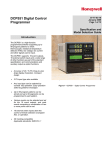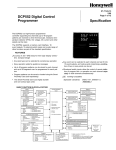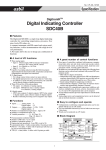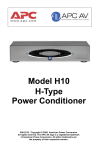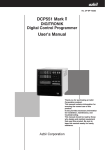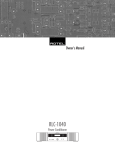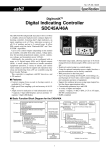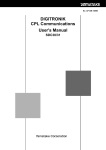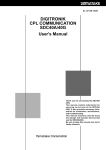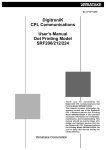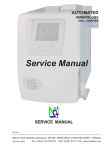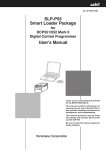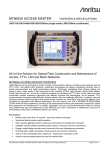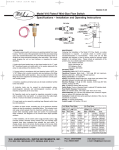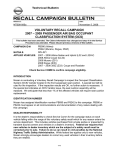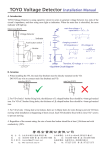Download DCP552B Mark II - Azbil Corporation
Transcript
No. CP-SS-1853E DCP552B Mark II DIGITRONIKTM Programmable Controller Overview The DIGITRONIKTM DCP552B Mark II is a high-function programmable controller supporting two channels (up to 49 program patterns per channel) to which thermocouple, resistance temperature detector (RTD), DC voltage, DC current and other signals can be input. The DCP552 Mark II supports 16 event outputs, 16 external switch inputs and a wide range of other functions as part of the standard specification. Features • Accuracy of ±0.1%FS. Easy-to-view large display characters. Compact design. • Any input type can be selected by console key operation. • Easy operation aided by guidance messages. • Up to 49 program patterns can be stored to each channel and up to 99 segments can be programmed to each pattern. • Any event can be selected to each channel and set for the 16 event outputs, and code events comprising a combination of two or more points can be set. • 16 external switch inputs allow the control of remote selection of program Nos. or operation on each channel separately or both channels simultaneously. • CE marking-compatible Applicable standards: EN61010-1, EN61326 Basic function blocks of DCP552B Mark II Input 1 • Root extraction • Linearization table approximation • Input bias • Filter • Thermocouple • Resistance temperature detector (RTD) • DC current • DC voltage Input 2 • Thermocouple • Resistance temperature detector (RTD) • DC current • DC voltage • O2 sensor *2 • Root extraction • Linearization table approximation • Input bias • Filter 12 external switch inputs • • • • RUN HOLD RESET ADV • • • • FAST RAMP-E AUTO/MANUAL AT • Program No. • CH1 operation cancel • CH2 operation cancel 4 external switch inputs • • • • Control operation block G.Soak cancel Direct/reverse action Autoload O2 sensor check • Mode transition • PID control • Auto-tuning • Direct/reverse action • ON-OFF control • SP limit • SP bias Key operation • Display selection • Display channel selection • Program No. • RUN/HOLD • RESET • ADV • • • • • • • Current-proportional • Voltage time-proportional • Open-collector time-proportional • Output change limiter • Upper/lower limiter • Current-proportional • Voltage time-proportional • Open-collector time-proportional Output 2 16 event outputs • • • • • • • Time event PV SP Deviation MV Code Code w/ timer • • • • PV SP Deviation MV • • • • • • • Modes Alarm Segment No. code Unique segments Program No. code PV rate-of-change O2 sensor error 1, 2 auxiliary outputs RS-485/RS-232C communications I/O FAST AUTO/MANUAL AT Program setup Parameter setup Memory card operation • • • • • • Output 1 • Output change limiter • Upper/lower limiter *1 *1 Loader communications I/O Program 2 channels x 49 patterns x 99 segments PID sets/output limiter sets Events • PV start G.Soak • Cycle PV shift • Pattern link Repeat • • • • • Parameter Variable parameters Event configuration PID parameter Setup Constant-value operation 1 *1: Option according to model No. *2: Thermocouple, RTD, DC current and DC voltage can be selected on models not supporting CP. Models supporting CP become O2 sensors. Specifications Program Inputs Number of programs 49 programs x 2 channels Number of segments 99 per program, total 2000 Segment setting system RAMP-X: Set by set points (SP) and time RAMP-T: Set by set points (SP) and ramp (θ) RAMP-E: Set by set points (SP) and ∆SP per external switch input 1 pulse Segment time 0 to 500 hours 0 minute, 0 to 500 minutes 0 second, 0.0 to 3000.0 seconds (time unit selectable) Segment ramp 1 to 10000 U/hour, 1 to 10000 U/minute, 1 to 10000 U/second (time unit selectable) Segment ∆SP 1 to 10000 U/1 pulse Number of subfunctions 4000 Sub-function action Events, PID set, output limiter set, G.Soak, PV shift, repeat Events (16) Set operating point corresponding to event type PID set No. Set 0 (continuation of previous segment), 1 to 9, A set (automatically switched) and ON-OFF control Output limiter set Set 0 (continuation of previous segment), 1 to 9 G.Soak Set type (start/end points and overall) and G.Soak width 0 to 1000 U. PV shift -10000 to +10000 U Repeat Set return destination segment No. and repeat count. PV start Set type (rising/falling or both) for each program. Cycle Set cycle count for each program. Pattern link Set program No.0 to 49 (0: no link) for each program. Tag Set 8 alphanumerics or symbols for each program. Basic time accuracy ±0.01% (segment time setting = 0, with 0.1 second delay for each repeat and cycle) Input type Thermocouple, resistance temperature detector (RTD), DC voltage, DC current multi-range (See pages 6, 7.) Sampling cycle 0.1 seconds Input bias current Thermocouple, DC voltage input:Max. ±1.3 µA (at peak value and reference conditions) 1 V or higher range: Max. -3 µA Input impedance DC current input: approx. 50 Ω (under operating conditions) Measuring current RTD input: Approx. 1 mA current flow from terminal A (under operating conditions) Influence of wiring resistance Thermocouple, DC voltage input:Thermocouple: 0.5 µV/Ω DC voltage (max. 1 V range): 0.5 µV/Ω DC voltage (5 V range): 3 µV/Ω DC voltage (10 V range): 6 µV/Ω RTD input:Max. ±0.01%FS/Ω in wiring resistance range 0 to 10 Ω Range of F01, F33, P01 and P33: ±0.02%FS/Ω max. RTD input allowable wiring resistance • Ranges other than F01, F33, P01 and P33: 85 Ω max. • Ranges of F01, F33, P01 and P33: 10 Ω max. Allowable parallel resistance Thermocouple disconnection detection allowable parallel resistance: 1 MΩ min. Max. allowable input Thermocouple, DC voltage input: -5 to +15V DC DC current input: 50 mA DC, 2.5V DC Burnout Detection selectable Over-range detection threshold 110%FS min.: Upscaled -10%FS max.: Downscaled (Note that F50 range is not downscaled.) Cold- junction compensation system Internal/external (0°C only) compensation selectable Scaling -19999 to +20000 U (possible in case of linear input only. Inverse scaling possible. Decimal point position settable at any point) Square root extraction Possible. Dropout: 0.2 to 10.0% in case of DC current or DC voltage range PV equalizer (linearization table approximation) PV1: 9 segments (10 points set) PV2: 9 segments (10 points set) CP: 9 segments (10 points set) Input bias -1000 to +1000 U variable Digital filter 0.0 to 120.0 seconds variable (0.0: filter OFF) Cold-junction compensation accuracy ±0.5°C (under standard conditions) 2 Number of inputs External switch inputs Types of connectable outputs Dry contacts (relay contact) and open-collector (current sink to ground) Terminal voltage (open) 8.5 V±0.5 V between common terminals (terminals conditions) Terminal current (short-circuit) Approx. 6 mA between each terminal (under operating conditions) Allowable contact resistance (dry contact) ON: 250 Ω max. (under operating conditions) OFF: 100 kΩ min. (under operating conditions) Voltage drop (at open-collector ON) 2 V max. (under operating conditions) Leakage current (at open-collector OFF) 0.1 mA max. (under operating conditions) Parallel connection with other instruments Can be connected to Azbil Corporation SDC40 and SDC10 series Assignments (fixed) RUN, HOLD, RESET, ADV, program No., CH1 operation cancel, CH2 operation cancel Assignments (variable) RAMP-E, FAST, AT, AUTO/MANUAL, G.Soak cancel, auto-load, O2 sensor check Input sampling cycle 0.1 seconds ON detection min. hold time 0.2 seconds (0.4 seconds for program No.) Upper display Indication/ programmer Modes 16 , ) and each input terminal (under operating Green 5-digit, 7-segment LED This displays PV values in the basic display state. Item codes are displayed in the parameter setup. Lower display Orange 5-digit, 7-segment LED This displays SP and output % in the basic display state. Setting values are displayed in the parameter setup. Program No. display Green 2-digit, 7-segment LED This displays program No. in the basic display state. Segment No. display Green 2-digit, 7-segment LED This displays segment No. in the basic display state. Item Nos. are displayed in parameter setup, and alarm No. is displayed when alarm occurs. Message display This displays output graph, deviation graph, event state and tags in the basic display state. This displays reference messages in the parameter setup and program setup. This displays operation details and operation results of memory card operation. Profile display 7 orange LEDs Displays program pattern rise, soak and fall trends. Status displays 22 round LEDs Modes: RUN, HLD, MAN, PRG (green) Display details: PV, SP, OUT, TM, CYC, SYN, DEV (green), EG1, EG2 (red) Battery voltage: BAT (red) (blinks at low voltage) Status: AT (green) Operation keys 18 rubber keys Loader connector port 1 (dedicated cable with stereo miniplugs) Program operation modes READY: Ready to run program (control stop/program No. selectable) RUN: Program run HOLD: Program hold FAST: Program fast-forward END: Program end READY FAST: Ready to run and fast-forward program AUTO: Automatic operation MANUAL: Manual operation (output can be controlled on console) Constant-value operation modes Controller READY: Ready to run program (control stop) RUN: Program run AUTO: Automatic operation MANUAL: Manual operation (output can be controlled on console) PID controls Proportional band (P) 0.0 to 1000.0% (0.0: ON-OFF control) Reset time (I) 0 to 3600 seconds. 0 seconds: PD control Rate time (D) 0 to 1200 seconds. 0 seconds: PI control MV limit Lower limit: -5.0 to upper limit % Upper limit: Lower limit to +105.0% Manual reset 0.0 to 100.0% 3 Controller Outputs PID controls Direct/reverse action switching Auxiliary output 16 sets for program operation (9 segment unique sets + 7 sets for automatic zone selection) PID set selection Segment designation/automatic zone selection can be switched by program operation. MV change 0.1 to 110.0%/0.1 seconds Auto-tuning Automatic setting of PID value by limit cycle system ON-OFF control differential 0 to 1000 U Possible Output types SP1, PV1, deviation 1, MV1, SP2, PV2, deviation 2, O2 sensor mV value Scaling Possible Current output (5G) CH1, CH2 auxiliary outputs CH1, CH2 Output current: 4 to 20 mA DC Allowable load resistance: 600 Ω max. (under operating conditions) Output accuracy: ±0.1%FS max. (under standard conditions) Output resolution: 1/10000 Max. output current: 21.6 mA DC Min. output current: 2.4 mA DC Output updating cycle: 0.1 seconds Open terminal voltage: 25 V max. Voltage output (6D) CH1, CH2 Allowable load resistance: 600 Ω max. (under operating conditions) Load current adjustment: 2 to 22 mA variable Variable open terminal voltage: 25 V max. OFF leakage current: 100 µA max. Output response time: At ON-OFF 600 Ω load: 0.5 ms max. At OFF-ON 600 Ω load: 0.5 ms max. Output resolution: 1/1000 Time-proportional cycle: 1 to 240 seconds variable Open-collector output (8D) CH1, CH2 External supply voltage: 12 to 24V DC Max. load current: 100 mA/load OFF leakage current: 0.1 mA max. ON residual voltage: 2 V max. Output resolution: 1/1000 Time-proportional cycle: 1 to 240 seconds variable Event outputs Open-collector output Event types Communications Number of PID sets External supply voltage: 12 to 24V DC Max. load current: 70 mA/load Max. common current: 500 mA OFF leakage current: 0.1 mA max. ON residual voltage: 2 V max. PV type PV, deviation, w/ deviation standby, absolute value deviation, w/ absolute value deviation standby, PV rate-of-change, SP, MV, G.Soak absolute value deviation, w/ G.Soak absolute value deviation standby, PV1 constant operation, PV2 constant operation Time type Time events, RAMP-E time monitor, segment time, program time Code type Code event, code event w/ timer, program No. binary code, segment No. binary code, program No. BCD code, segment No. BCD code Mode type Unique segment, RUN+HOLD+END+FAST, HOLD, READY+READY FAST, END, G.Soak standby, MANUAL, AT executing, FAST+READY FAST, console operation in progress, RUN, advance, all alarms, PV range alarm, controller alarm, O2 sensor error, low battery voltage Event hysteresis In case of PV type set, 0 to 1000 U Event ON delay 0.0 to 3000.0 can be set to four events RS-485 Network Multidrop This controller is provided with only slave instrument functionality except when connected to ST221 (dedicated display device). 1 to 16 units max. (DIM) 1 to 31 units max. (CMA, SCM) Data flow Half duplex Synchronization Start-stop synchronization Transmission system Balanced (differential) Data line Bit serial Signal line 5 transmit/receive lines (3-wire connection also possible) Transmission speed 1200, 2400, 4800, 9600 bps Transmission distance 500 m max. (total) (300 m max. for MA500 DIM connection) Other Conforming to RS-485 interface specifications 4 Communications RS-485 Char. bit count 11 bits/character Format 1 start bit, even parity, 1 stop bit; or 1 start bit, no parity, and 2 stop bits Data length 8 bits Isolation All inputs and outputs are completely isolated except external switch inputs. RS-485 communications can be performed by connecting to a computer equipped with an RS-485 interface or to Azbil Corporation MX200, MA500 (DK link II DIM) or CMA50 controllers. RS-232C Memory backup General specifications Rated power voltage Network 1: 1 Connected, This controller is provided with only slave instrument functionality. Data flow Half duplex Synchronization Start-stop synchronization Transmission system Unbalanced type Data line Bit serial Signal line 3 transmit/receive lines Transmission speed 1200, 2400, 4800, 9600 bps Transmission distance 15 m max. Other Conforming to RS-232C interface specifications Char. bit count 11 bits/character Format 1 start bit, even parity, 1 stop bit; or 1 start bit, no parity, and 2 stop bits Data length 8 bits Isolation All inputs and outputs are completely isolated except external switch inputs. Memory: Battery backed up RAM Battery life:Controller power OFF: Approx. 5 years under standard conditions Controller power ON: Approx. 10 years under standard conditions 100 to 240V AC, 50/60 Hz Power consumption 40 VA max. Power ON rush current 50 A max. Power ON operation Reset time: 10 seconds max. (time until normal operation is possible under normal operating conditions) Allowable transient power loss 20 ms max. (under operating conditions) Insulation resistance Min. 50 MΩ across power terminal Dielectric strength 1500V AC 50/60 Hz for 1 minute between power terminal and FG terminal or and FG terminal or (by 500V DC megger) Note)The primary side and secondary side capacities are joined inside the product. For this reason, when carrying out a withstand voltage test, disconnect the wiring of the grounded secondary side terminals (e.g. when grounding type thermocouple is used) from that terminal. If the test is carried out with the wiring as it is, this might result in malfunction. Standard conditions Ambient temperature 23±2°C Ambient humidity 60±5%RH Rated power voltage 105V AC ±1% Power frequency 50±1 Hz, or 60±1 Hz Vibration resistance 0 m/s2 Shock resistance 0 m/s2 Mounting angle Reference plane (vertical) ±3° 5 Operating conditions General specifications Ambient temperature range 0 to 50°C (ambient temperature at the bottom side of case when gang-mounted) Ambient humidity range 10 to 90%RH (condensation not allowed) Rated power voltage 100 to 240V AC Allowable power voltage 90 to 264V AC Power frequency 50±2 Hz, or 60±2 Hz 0 to 1.96 m/s2 Vibration resistance 0 to 9.80 m/s2 Shock resistance Transport/storage conditions Mounting angle Reference plane (vertical) ±10° Ambient temperature range -20 to +70°C Ambient humidity range 10 to 95%RH (condensation not allowed) 0 to 4.90 m/s2 (10 to 60 Hz for 2 hours each in X, Y and Z directions) Vibration resistance Standard accessories Shock resistance 0 to 490 m/s2 (3 times vertically) Package drop test Drop height: 60 cm (1 angle, 3 edges and 6 planes; free fall) Terminal screw M3.5 self-tapping screws Terminal screw tightening torque 0.78 to 0.98 N·m Mask/case materials Mask: Multilon Mask/case color Mask: Dark gray (Munsell 5Y3.5/1) Case: Light gray (Munsell 2.5Y7.5/1) Installation Specially designed mounting bracket Weight Approx. 1.5 kg Item Unit indicating label Model No. Q'ty 81446044-001 1 set (2 p'ces) — Mounting bracket 1 81446176-001 Terminal cover Auxiliary parts Item (sold separately) Soft dust-proof cover set 1 CP-UM-5017E User's manual Case: Multilon Lithium battery set Input type Code Range No. K (CA) K09 0 K (CA) K04 K (CA) K (CA) E (CRC) J (IC) T (CC) K46 K08 E08 J08 °C Input range (FS) °F -200.0 to +200.0 -300.0 to +400.0 ±0.1%FS 1 0.0 to 800.0 0 to 1600 ±0.1%FS 3 4 0.0 to 1200.0 0 to 2400 0.0 to 400.0 0.0 to 800.0 0.0 to 800.0 0 to 750 0 to 1800 0.0 to 1600 ±0.1%FS ±0.1%FS ±0.1%FS B18 T44 5 -200.0 to +300.0 -300 to +700 ±0.1%FS R (PR13) R16 7 0.0 to 1600.0 0 to 3100 ±0.1%FS W (WRe5-26) W23 9 0.0 to 2300.0 0 to 4200 ±0.1%FS PR40-20 D19 S (PR10) W (WRe5-26) N PLII Ni-Ni·Mo Golden iron chromel S16 W14 U13 Y13 Z13 Z06 8 10 11 12 13 14 15 Approx. 200 g ±0.1%FS B (PR30-6) 6 — Accuracy (under standard conditions) 16 2 81446140-001 Q'ty 1 Table 1 Input types and ranges (selectable in setup) •Thermocouple Symbol Model No. 81446141-001 0.0 to 1800.0 0 to 3300 0.0 to 1600.0 0 to 3100 0.0 to 1400.0 0 to 2552 0.0 to 1900.0 0.0 to 1300.0 0.0 to 1300.0 0.0 to 1300.0 0 to 3400 32 to 2372 32 to 2372 32 to 2372 0.0 to 300.0 K (K: Kelvin) Thermocouple:K, E, J, T, B, R, S (JIS C 1602-1981) WRe5-26 (Hoskins Data) PR40-20 (Johnson Matthey Data) N (N.B.S. Monograph 161) PLII (Engelhard Industries Data (IPTS68)) Ni-NiMo (General Electric Data) Gold iron chromel (Hayashidenko Data) 6 ±0.1%FS ±0.3%FS between -200°C to -45°C ±4.0%FS between 0 to 260°C, ±0.15%FS between 260 to 800°C ±0.1%FS ±0.1%FS ±0.2%FS ±0.1%FS ±0.1%FS ±0.1%FS ±0.4%FS ±0.9%FS between 0 to 300°C, ±0.5%FS between 300 to 800°C •Resistance temperature detector (RTD) Symbol JIS'89Pt100 (IEC Pt100 Ω) Input type Code Range No. F46 65 F50 64 F32 F36 F33 F03 JIS'89JPt100 68 -40.0 to +60.0 -40.0 to +140.0 70 P50 96 97 P32 P36 0.0 to 100.0 0.0 to 300.0 -50.0 to +400.0 -200.0 to +500.0 -200.0 to +200.0 ±0.1%FS ±0.1%FS ±0.15%FS 0.0 to 200.0 ±0.15%FS 0.0 to 900.0 ±0.1%FS 0.0 to 500.0 0.0 to 500.0 ±0.1%FS ±0.1%FS -300.0 to +900.0 -300.0 to +400.0 ±0.1%FS ±0.1%FS ±0.1%FS -100.0 to +150.0 -150.0 to +300.0 100 -40.0 to +60.0 -40.0 to +140.0 ±0.15%FS 0.0 to 300.0 0.0 to 500.0 ±0.1%FS P01 101 P05 103 P03 -50.0 to +200.0 Accuracy (under standard conditions) 98 99 P33 -300.0 to +900.0 -300.0 to +400.0 -150.0 to +300.0 71 P46 -200.0 to +500.0 -200.0 to +200.0 °F -100.0 to +150.0 69 F05 Input range (FS) 66 67 F01 °C 102 -50.0 to +200.0 0.0 to 100.0 0.0 to 500.0 -50.0 to +400.0 0.0 to 200.0 0.0 to 900.0 ±0.1%FS ±0.1%FS ±0.15%FS ±0.1%FS Resistance temperature detector (RTD): Pt100, JPt100 (JIS C 1604-1989) •DC current, DC voltage Symbol mA (linear) mV (linear) mA (linear) V (linear) Input type Range No. Z51 52 2.4 to 20 mA 50 -10 to +10 mV C01 128 4 to 20 mA — 129 C01 48 M01 49 — 51 L02 Z51 — V01 — O2 sensor * Input range (FS) Code — — 4 to 20 mA 0 to 10 mV 0 to 100 mV 134 2.4 to 20 mA 130 -1 to +1 V 131 132 133 135 0 to 1 V Programmable range -19999 to +20000 (decimal point position can be changed) Programmable range -19999 to +20000 (decimal point position can be changed) 1 to 5 V Accuracy (under standard conditions) ±0.1%FS ±0.1%FS ±0.1%FS ±0.1%FS ±0.15%FS ±0.15%FS ±0.1%FS ±0.1%FS ±0.1%FS ±0.1%FS 0 to 5 V ±0.1%FS 0 to 10 V 0 to 1250 mV Carbon potential (CP value) indication range: 0.000 to 4.000%C (Note that PID control is calculated in input range 0.000 to 2.000%C.) O2 partial pressure (PO2) indication range: 0.000 to 1.500 x 10-20 atm ±0.1%FS ±0.1%FS When converted to mV value * •Any O2 sensor made by Japan Glass Co., Ltd., Marathon Monitors, Cambridge, Corning, AACC (Advanced Atmosphere Control Corporation), Barber Colman and Furnace Control can be used. •PV2 is fixed for the O2 sensor in the case of models supporting carbon potential. • • • • Handling Precautions The unit of code Z06 is Kelvin (K). The PV lower limit alarm does not occur with codes F50 and P50. The number of digits past the decimal point for DC current and DC voltage is programmable within the range 0 to 4. The PV upper limit alarm is output by the O2 sensor when the voltage exceeds 1375 mV. The PV lower limit alarm, however, is not output. 7 Model selection guide I II Basic model No. III — DCP552 I Number of PV inputs B IV Carbon potential V II III IV V VI Option VI Example: DCP552B20100 Specifications Additions Digital Programmable Controller (2-loop model) Mark II 2 PV input CH2 0 1 None Available 0 None 1 Auxiliary output CH1 2 00 D0 Y0 Auxiliary output CH2, communications None Inspection certificate Complying with the traceability certification External dimensions (Unit: mm) 15.5 144 185 3 137 9 PROG PV DEV OUT CYC SP TM SYN RUN HLD MAN PRG 7 1 2 3 4 5 6 7 8 9 10 11 12 13 14 15 16 17 18 19 20 21 22 23 24 25 26 27 28 29 30 31 32 33 34 35 36 37 38 39 40 41 42 43 44 45 46 47 48 49 50 51 52 53 54 55 56 57 58 59 60 61 62 63 64 SEG PROFILE AT BAT EG1 EG2 137 RESET MESSAGE 161 144 ADV PROG RUN/HOLD DISP MESSAGE A/M FUNC PID AT PARA SETUP CLR ENTER LOAD LOADER SAVE 7 Panel cutout (Unit: mm) 450 min. +1 138 0 +1 138 0 200 min. 8 Operation mode selection by external switch input Event outputs (16) EV1 EV2 EV3 EV4 EV5 EV6 EV7 EV8 EV9 EV10 EV11 EV12 EV13 EV14 EV15 EV16 Load Load Load Load Load Load Load Load Load Load Load Load Load Load External switches Load ADV RESET RUN HOLD SW1 SW2 SW3 SW4 SW5 SW6 SW7 SW8 Load Wiring External power supply 12 to 24V DC External power supply 12 to 24V DC Common Remote program No. selection by external switch input (BCD) 1 SW9 2 SW10 4 SW11 8 SW12 10 SW13 SW14 SW15 SW16 External switch 20 1 2 3 4 5 6 7 8 9 10 11 12 13 14 15 16 17 18 19 20 21 22 23 24 25 26 27 28 29 30 31 32 33 34 35 36 37 38 39 40 Noise filter 4 CH1 cancel CH2 cancel 41 42 Common 54 43 44 45 CH1 control output 55 46 47 48 CH2 control output 56 57 Input CH1 58 49 50 51 52 Auxiliary Auxiliary output 1 output 2 59 60 61 62 63 Instrument power supply 90 to 264V AC 1 GND E 3 2 53 FG 64 Frame ground terminals 52 and 53 are common. Input CH2 Communications I/O ●● Input •PV input CH1 RTD input Thermocouple input + Current input — 54 55 55 56 + + 54 55 — + + — — 56 54 55 56 54 C A T/C RTD Voltage input Current (mA) oscillator B — 56 Voltage (mV/V) oscillator •PV input CH2 RTD input Thermocouple input + Current input — 57 58 — 59 57 58 59 C T/C A RTD B 57 58 — Voltage input + + 57 58 + + — 59 Current (mA) oscillator O2 sensor input — — Voltage (mV/V) oscillator 59 57 + 58 59 — + O2 sensor Note: If voltage mode signals are input to PV input CH1 (terminal Nos. , ) and input CH2 (terminal Nos. , ) for current input by mistake, a large current might flow and cause the controller to malfunction. Before wiring to the current input terminals on the DCP552B, make sure that current input signals are output correctly within the range 4 to 20 mA. 9 ●● Control output and auxiliary output •Control output Current output Voltage output CH1 control output (current output) CH2 control output (current output) CH1 control output (voltage output) CH2 control output (voltage output) + — + — + — + — 43 44 45 46 43 44 45 46 + + — Load + — SSR Load Open collector output CH1 control output (voltage output) CH2 control output (current output) + — + — 43 44 45 46 12 to 24V DC Load 12 to 24V DC Load •Auxiliary output CH1 CH2 + — + — 48 49 50 51 + — + — Receiver Receiver 10 — + SSR — ●● Internal circuit of external switch input Internal circuit +5 V (separate 5 V from internal voltage) External switch 1 16 12 or 25 or 38 or 41 Internal GND Separate GND in addition to internal ground (GND for above 5 V) ●● Communications I/O (option) RS-485 3-wire type RS-485 5-wire type Slave instrument (DCP552B) Slave instrument (DCP552B) SDA SDB RDA RDB SG SDA SDB RDA RDB SG 60 61 62 63 64 60 61 62 63 64 Slave instrument (DCP552B) Slave instrument (DCP552B) SDA SDB RDA RDB SG SDA SDB RDA RDB SG 60 61 62 63 64 60 * * + — SG RS-232C Converter ECL * * PC etc. RS-232C (DCP552B) FG 52 SD RD SG 61 63 64 2 3 7 1 Master instrument (terminal type connection) 4 5 6 8 61 20 * SDA SDB RDA RDB SG Converter * 62 63 64 * Attach a terminator (1/2 W or more, 150 Ω) to both ends of the communications path. RS-232C PC, PLC etc. Note (1) In the case of a modem type connected master instrument, connect terminals 2 and 61, and 3 and 63 in reverse to the above figure. (2) The RS-232C terminals 4-5 and 6-8-20 on the computer must be short-circuited as shown in the figure on the left. (3) In the case of a computer whose RS-232C terminals 1 and 7 are for the same signal, do not connect the leads as shown in the above figure. Also, do not connect the sleeve marked "FG" to any terminal at all. 11 (1) Fast-rising noise CR filters are effective in countering fast-rising noise. Recommended CR filter: Azbil Corporation Model No. 81446365-001 ■■Wiring precautions 1.Isolating inputs and outputs inside the controller Solid lines Dotted lines show isolated items. show non-isolated items. PV input CH1 (2) Noise with a high wave height Varisters are effective in countering noise with a high wave height. However, note that the varister may become short-circuited when trouble occurs. Pay attention to this when providing a varister on a controller. Recommended varister: Azbil Corporation Model No. 81446366-001 (for 100V AC) 81446367-001 (for 200V AC) Control output CH1 PV input CH2 Loader communications External switch input Auxiliary output CH1 Digital circuit Control output CH2 Auxiliary output CH2 Communications Event output 2.Noise countermeasures for Instrument power supplies (1) Reducing noise Connect the DCP552B to a single-phase power supply for instruments, and take measures to prevent the influence of electrical noise. Instrument power supply 100 to 240V AC Noise filter 4.Ground Use only the FG terminal or on the DCP552B for grounding. Do not ground across other terminals. When it is difficult to ground shielded cable, prepare a separate GND terminal plate (earth bar). Ground type: 100 Ω max. Ground cable: 2 mm2 min. annealed-copper wire (AWG14) Cable length: Max. 20 m 1 ~ 2 Shielded GND 52 or 53 (2) When there is a lot of noise If there is a lot of electrical noise, we recommend inserting an insulating transformer in the power circuit and using a line filter. Instrument power supply 100 to 240V AC Insulating transformer (100/100 V, 200/200 V) GND (100 Ω min.) Line filter Azbil Corporation Model No. 81446364-001 1 ~ E 2 DCP552 5.Precautions during wiring (1)After providing anti-noise measures, do not bundle primary and secondary power leads together, or pass them through the same piping or wiring duct. (2)Maintain a distance of at least 50 cm between I/O signal leads or communications leads and the power lead. Also, do not pass these leads through the same piping or wiring duct. 39 3 GND 40 4 52 or 53 Other circuit GND GND terminal plate (earth bar) GND 3.Noise generating sources and countermeasures Generally, the following generate electrical noise: Relays and contacts, electromagnetic coils, solenoid valves, power lines (in pa r ticula r, 90V AC m in.), induction loads, inverters, motor commutators, phase angle control SCR, radio communications equipment, welding equipment, high-voltage ignition equipment 6.Inspection after wiring After wiring is completed, be sure to inspect and check the wiring state. Wrong wiring may cause controller malfunction or accidents. 12 1st Edition: Issued in May 2008 3rd Edition: Issued in Dec. 2013












